Abstract
The effect of pretreatment with ultraviolet-B (UV-B) light (280-320 nanometers) on the enzymatic conversion of the diepoxyxanthophyll violaxanthin to the epoxy-free zeaxanthin occurring in thylakoid membranes was investigated. When isolated chloroplasts of pea (Pisum sativum) were exposed to UV-B, a biologically effective fluence of 7000 joules per square meter caused about 50% inhibition of the activity of the violaxanthin deepoxidase, measured as the first order rate constant of the absorbance change at 505 nanometers. The dose requirement for the inhibition of the deepoxidase in intact leaves, however, was about 2 orders of magnitude higher. The inhibition of the rate constant was observed for both the dark deepoxidation at pH 5, and for the light-driven deepoxidation induced by the lumen acidification due to electron transport from H2O to methylviologen or due to a photosystem I partial reaction with duroquinol as the electron donor. The availability of violaxanthin was not directly affected by UV-B radiation, as shown for UV-B-treated chloroplasts by the final extent of the 505 nanometer change measured in the dark at pH 5 or by the partial photosystem I reaction. A significant decrease in the violaxanthin availability was observed when lumen acidification was caused by electron transport from H2O to methylviologen. That effect was probably caused by the wellknown UV-B inhibition of photosystem II with a subsequent decreased ability to reduce the plastoquinone pool, the redox state of which is believed to regulate the final amount of converted violaxanthin.
Full text
PDF
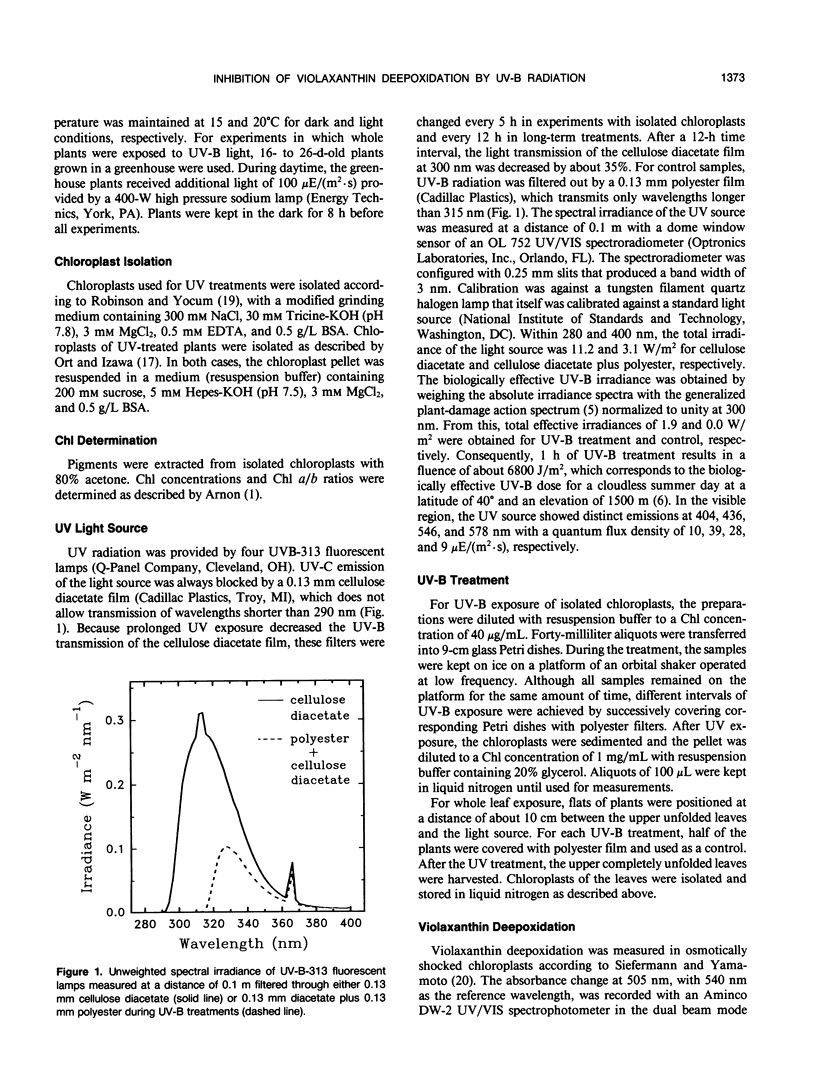
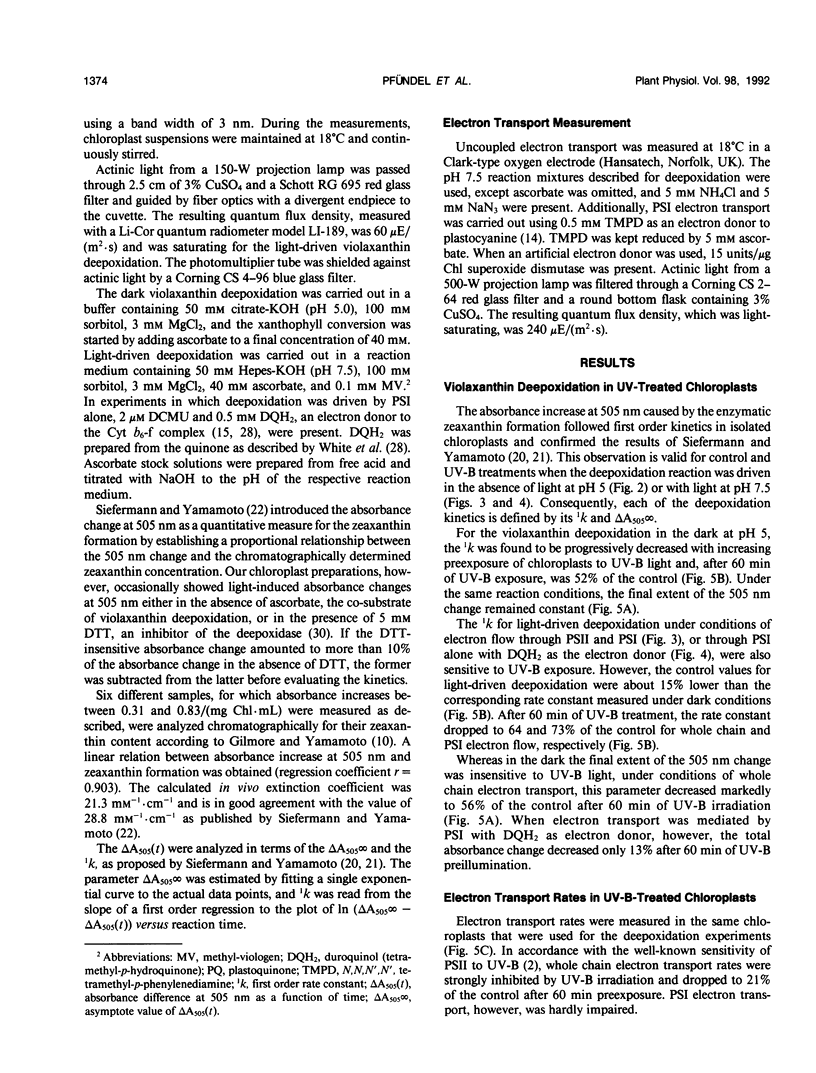
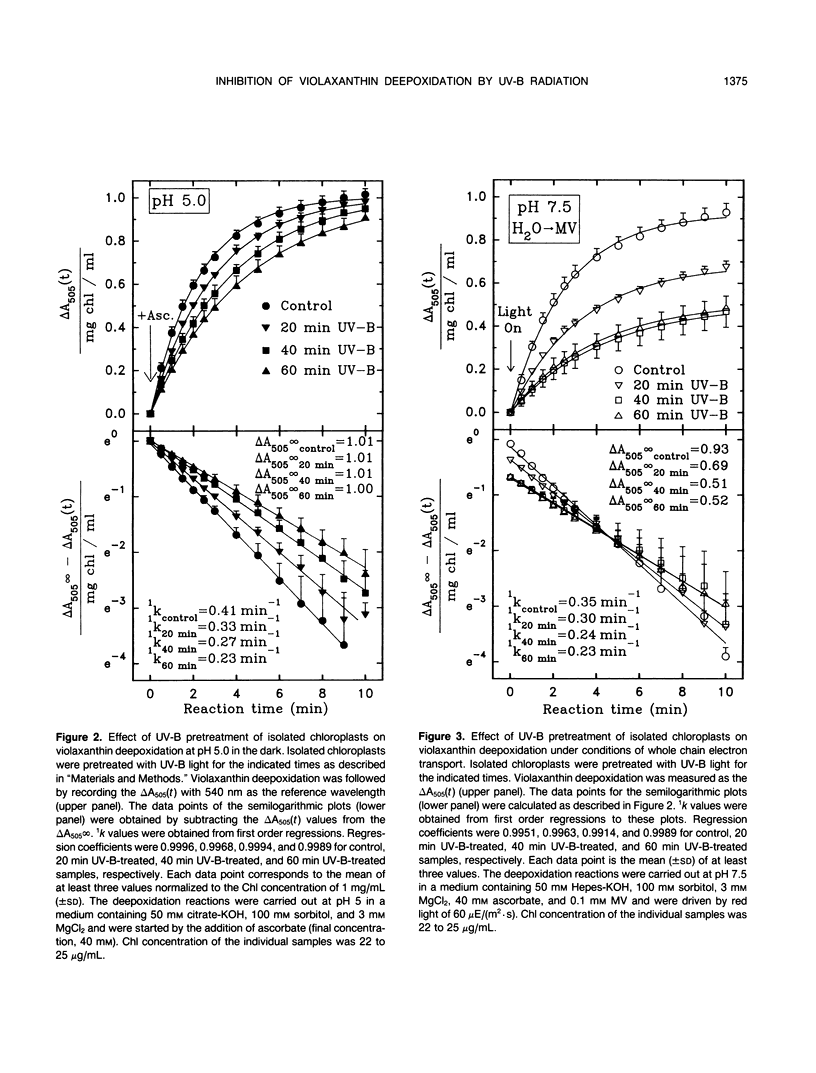

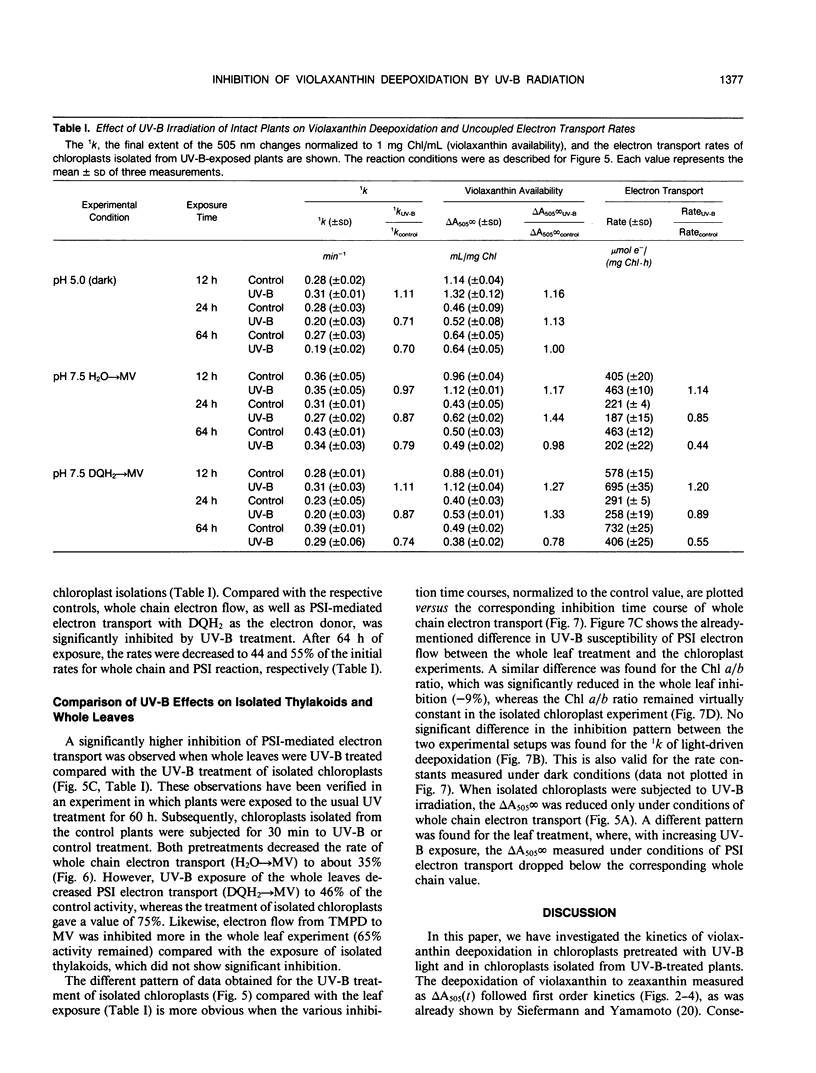
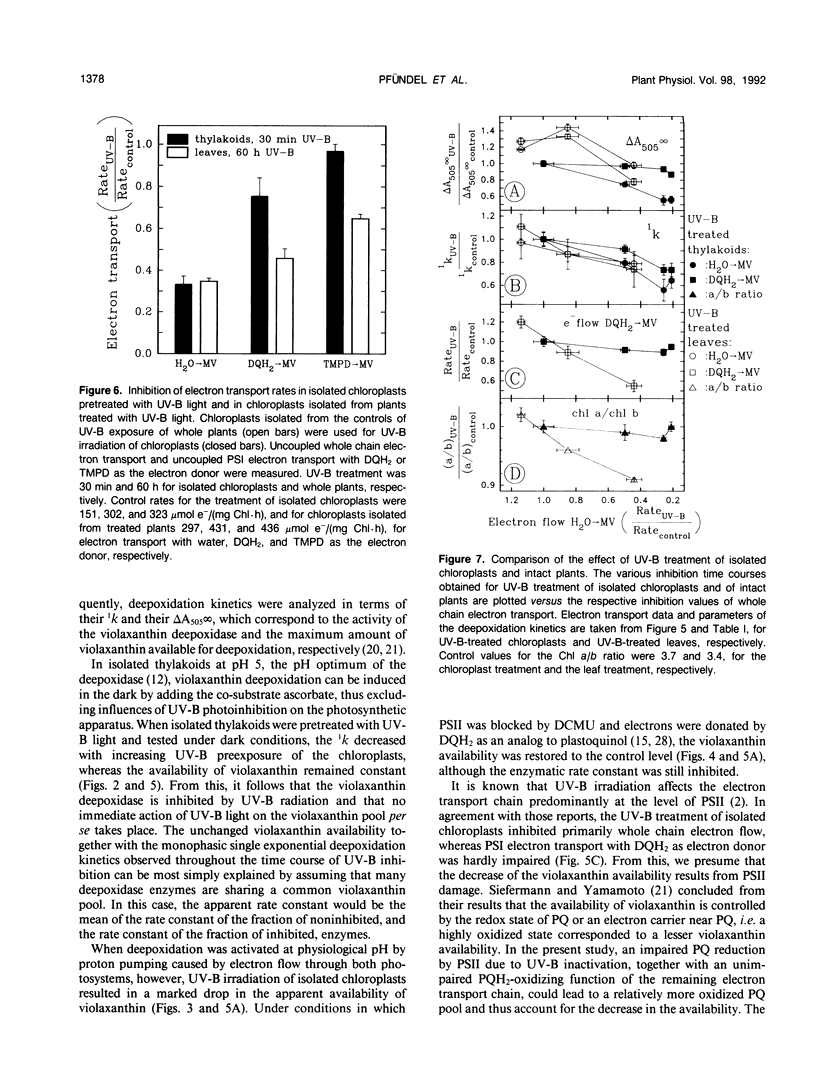

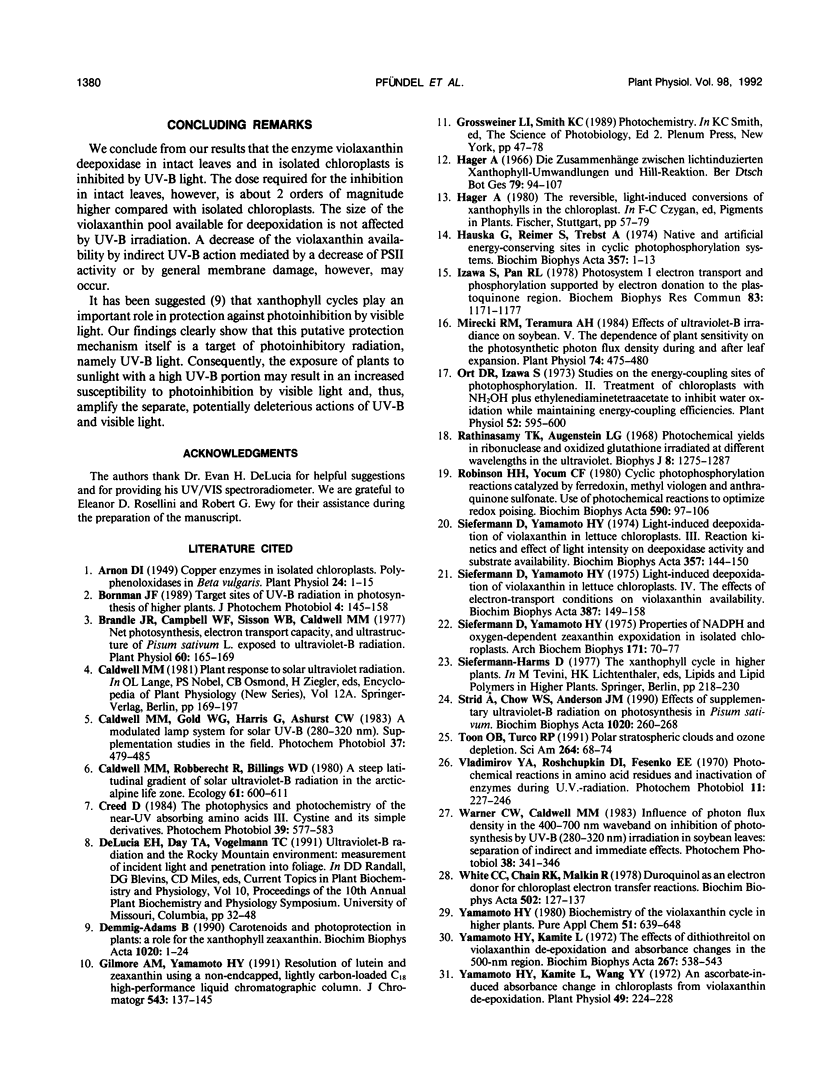
Selected References
These references are in PubMed. This may not be the complete list of references from this article.
- Arnon D. I. COPPER ENZYMES IN ISOLATED CHLOROPLASTS. POLYPHENOLOXIDASE IN BETA VULGARIS. Plant Physiol. 1949 Jan;24(1):1–15. doi: 10.1104/pp.24.1.1. [DOI] [PMC free article] [PubMed] [Google Scholar]
- Brandle J. R., Campbell W. F., Sisson W. B., Caldwell M. M. Net Photosynthesis, Electron Transport Capacity, and Ultrastructure of Pisum sativum L. Exposed to Ultraviolet-B Radiation. Plant Physiol. 1977 Jul;60(1):165–169. doi: 10.1104/pp.60.1.165. [DOI] [PMC free article] [PubMed] [Google Scholar]
- Caldwell M. M., Gold W. G., Harris G., Ashurst C. W. A modulated lamp system for solar UV-B (280--320 nm). Supplementation studies in the field. Photochem Photobiol. 1983 Apr;37(4):479–485. doi: 10.1111/j.1751-1097.1983.tb04503.x. [DOI] [PubMed] [Google Scholar]
- Hauska G., Reimer S., Trebst A. Native and artificial energy-conserving sites in cyclic photophosphorylation systems. Biochim Biophys Acta. 1974 Jul 25;357(1):1–13. doi: 10.1016/0005-2728(74)90106-6. [DOI] [PubMed] [Google Scholar]
- Izawa S., Pan R. L. Photosystem I electron transport and phosphorylation supported by electron donation to the plastoquinone region. Biochem Biophys Res Commun. 1978 Aug 14;83(3):1171–1177. doi: 10.1016/0006-291x(78)91518-8. [DOI] [PubMed] [Google Scholar]
- Mirecki R. M., Teramura A. H. Effects of Ultraviolet-B Irradiance on Soybean : V. The Dependence of Plant Sensitivity on the Photosynthetic Photon Flux Density during and after Leaf Expansion. Plant Physiol. 1984 Mar;74(3):475–480. doi: 10.1104/pp.74.3.475. [DOI] [PMC free article] [PubMed] [Google Scholar]
- Ort D. R., Izawa S. Studies on the Energy-coupling Sites of Photophosphorylation: II. Treatment of Chloroplasts with NH(2)OH Plus Ethylenediaminetetraacetate to Inhibit Water Oxidation while Maintaining Energy-coupling Efficiencies. Plant Physiol. 1973 Dec;52(6):595–600. doi: 10.1104/pp.52.6.595. [DOI] [PMC free article] [PubMed] [Google Scholar]
- Rathinasamy T. K., Augenstein L. G. Photochemical yields in ribonuclease and oxidized glutathione irradiated at different wavelengths in the ultraviolet. Biophys J. 1968 Nov;8(11):1275–1287. doi: 10.1016/S0006-3495(68)86555-5. [DOI] [PMC free article] [PubMed] [Google Scholar]
- Robinson H. H., Yocum C. F. Cyclic photophosphorylation reactions catalyzed by ferredoxin, methyl viologen and anthraquinone sulfonate. Use of photochemical reactions to optimize redox poising. Biochim Biophys Acta. 1980 Mar 7;590(1):97–106. doi: 10.1016/0005-2728(80)90149-8. [DOI] [PubMed] [Google Scholar]
- Siefermann D., Yamamoto H. Y. Light-induced de-epoxidation of violaxanthin in lettuce chloroPLASTS. III. Reaction kinetics and effect of light intensity on de-epoxidase activity and substrate availability. Biochim Biophys Acta. 1974 Jul 25;357(1):144–150. doi: 10.1016/0005-2728(74)90119-4. [DOI] [PubMed] [Google Scholar]
- Siefermann D., Yamamoto H. Y. Light-induced de-epoxidation of violaxanthin in lettuce chloroplasts. IV. The effects of electron-transport conditions on violaxanthin availability. Biochim Biophys Acta. 1975 Apr 14;387(1):149–158. doi: 10.1016/0005-2728(75)90059-6. [DOI] [PubMed] [Google Scholar]
- Siefermann D., Yamamoto H. Y. Properties of NADPH and oxygen-dependent zeaxanthin epoxidation in isolated chloroplasts. A transmembrane model for the violaxanthin cycle. Arch Biochem Biophys. 1975 Nov;171(1):70–77. doi: 10.1016/0003-9861(75)90008-9. [DOI] [PubMed] [Google Scholar]
- Vladimirov Y. A., Roshchupkin D. I., Fesenko E. E. Photochemical reactions in amino acid residues and inactivation of enzymes during U.V.-irradiation. A review. Photochem Photobiol. 1970 Apr;11(4):227–246. doi: 10.1111/j.1751-1097.1970.tb05992.x. [DOI] [PubMed] [Google Scholar]
- White C. C., Chain R. K., Malkin R. Duroquinol as an electron donor for chloroplast electron transfer reactions. Biochim Biophys Acta. 1978 Apr 11;502(1):127–137. doi: 10.1016/0005-2728(78)90137-8. [DOI] [PubMed] [Google Scholar]
- Yamamoto H. Y., Kamite L. The effects of dithiothreitol on violaxanthin de-epoxidation and absorbance changes in the 500-nm region. Biochim Biophys Acta. 1972 Jun 23;267(3):538–543. doi: 10.1016/0005-2728(72)90182-x. [DOI] [PubMed] [Google Scholar]
- Yamamoto H. Y., Kamite L., Wang Y. Y. An Ascorbate-induced Absorbance Change in Chloroplasts from Violaxanthin De-epoxidation. Plant Physiol. 1972 Feb;49(2):224–228. doi: 10.1104/pp.49.2.224. [DOI] [PMC free article] [PubMed] [Google Scholar]


